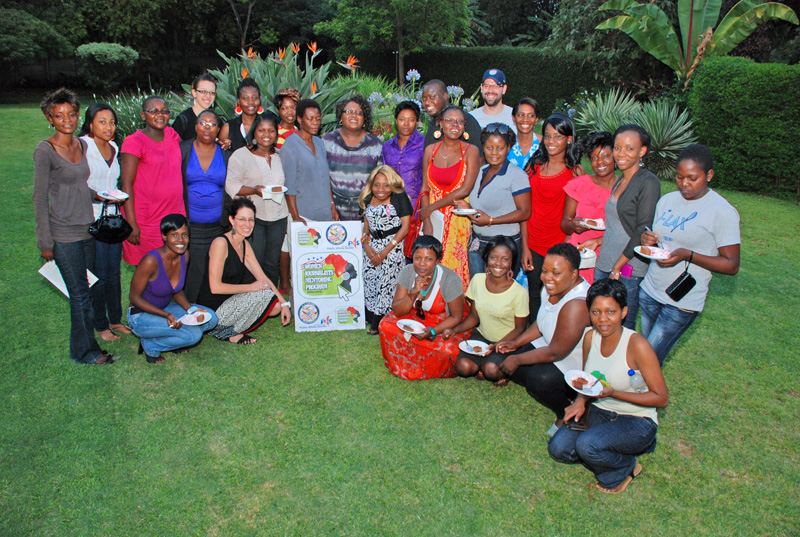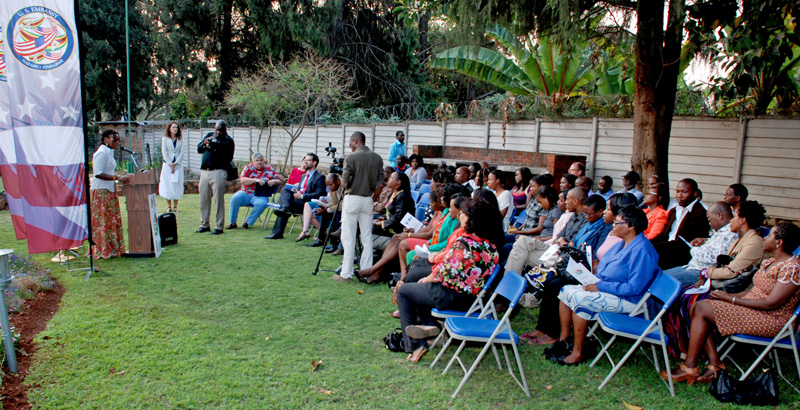The CPD Blog is intended to stimulate dialog among scholars and practitioners from around the world in the public diplomacy sphere. The opinions represented here are the authors' own and do not necessarily reflect CPD's views. For blogger guidelines, click here.
From A Whisper to A Shout: Promoting Women in Zimbabwean Newsrooms
One of America’s flagship weekly national news magazines, Newsweek, faced a Title VII Civil Rights Act gender discrimination case from 46 of its female employees in 1970. Despite that important case so many years ago, in 2009 a group of Newsweek’s female reporters wrote with dismay that not much had changed. 43 of 49 Newsweek cover stories that year were written by men, and, across America, women got only one byline at a major magazine for every seven bylines by their male colleagues. According to a 2013 report by Diana Mitsu Klos of the Women’s Media Center, this trend has not improved and may be getting worse.

Kick off program for the 2012-13 (second program year) of the WJM
These types of statistics are not unique to the U.S. They are, in fact, much worse in many regions of the world. The impact is real and negative. The female half of humanity is, in many places, simply absent from the news. According to the Global Media Monitoring Project’s 2010 report Who makes the news?, worldwide only 24% percent of people written about or quoted in the news are women; male spokesmen make up 81% of quoted sources; and 80% of referenced experts are men.
In Zimbabwe, a country that has suffered great political turmoil and economic instability since its independence in 1980, traditional African patriarchal culture further negatively impacts women in the workplace, including in the media. In 2010, women were only 16% of journalists in Zimbabwe. This was the lowest percentage in the southern African region, which had an average of 28% female reporters in newsrooms. Zimbabwean women journalists are more likely to have less lucrative, short-term contracts and tend to cover gender beats rather than politics and sports. Sexual harassment is also a major threat to women in Zimbabwean workplaces. Researchers report that one in three Zimbabwean women have reported being sexually harassed. The media realm is filled with anecdotal stories of well-known, senior male editors targeting female interns in the newsroom, leading the Zimbabwe Union of Journalists to launch a major campaign on World Press Freedom Day 2012 to address the problem.

On top of the general difficulties faced by female Zimbabwean journalists, they are almost completely excluded from the highest levels of the media. Women hold only 13% of top media management positions and 10% of senior jobs in the Zimbabwean media, according to a 2009 survey by the South African NGO Genderlinks. Additionally, men are more prevalent across many departments, comprising 83% of editorial jobs and 100% of technical, information technology, printing, and distribution divisions. When the Zimbabwe Media Commission began issuing licenses for new print media outlets in 2009, no women applied.
While certainly not at gender parity, South Africa has some of the better numbers in the region for women in reporting and senior media positions. I served there as U.S. Embassy press attaché from 2007-10 and knew many powerful, brilliant women journalists and editors. Coming to Zimbabwe and seeing not a single woman editor was striking. After one year on the ground, I pulled my team together to create a Women Journalists Mentoring (WJM) program. Our ambitious goal was to give a small, diverse group of journalists intensive training and mentoring over one year to build their skill base and confidence, and to encourage them to be their own advocates for radical change in a stagnant environment.
Veteran women’s activist and journalist, Virginia Muwanigwa, speaks at the graduation ceremony of the 1st year of the WJM (September 2012)
There are multiple elements to the program -- one-on-one mentoring, short course trainings, breakfast roundtables with senior journalists, and professional development trips to South Africa. One of our breakfast roundtable speakers, Regina McCombs, introduced us to the Poynter Institute’s NewsU, with which we designed a certificate program for our group. Zimbabwean journalism programs are handicapped by a lack of resources and the flight of senior journalists and teachers during the political and economic collapse of the last decade. Thanks to the Poynter program, our women learned some journalism basics, new media trends, and management skills.
The WJM program is now in its second year and the women have built a strong professional network. The first year graduates have received promotions, started their own associations of women photographers and sports journalists, and won some international recognition. They are slowly starting to break the glass ceiling and claim their place on political desks and at management tables.

U.S. Embassy Harare’s Counselor for Public Affairs, Sharon Hudson-Dean, introduces speakers at a Ladies Night at the Quill Club (Harare press club) on the topic of how the media cover women in business
My team is now working with the main Zimbabwean media associations and advocacy groups to map out the institutional changes that must occur in parallel to this professional development to enact long-term change. One initiative that has really blossomed is our series of monthly Ladies Nights at the Harare Quill Press Club. The Quill has been an all-male bastion since the days of Ian Smith, scaring away women journalists and giving great advantage to the men who share tips and contacts there. Our Ladies Nights alter the focus (at least for a few hours) from drinking back to the profession. Each one features a panel discussion on topics related to women in the media and coverage of women by the media. Over a year old, they are now a popular, regular fixture of the club’s calendar, and women are starting to feel more comfortable and familiar in the Quill.
The Women Journalists Mentoring program is about building confidence and space. Zimbabwean women belong in the editors’ and owners’ chairs, and we are materially supporting their progress in that direction. Our 2012 graduates report back that they now actively engage in daily editorial diary sessions and influence the types and angles of stories at their news organizations. Their male editors and media managers also tell us that these women are starting to shift newsroom attitudes in favor of women reporters thanks to their heightened professionalism and self-awareness. In an African country with deep roots in a patriarchal traditional culture, these women have the potential to transform their society in a positive, long-lasting way. They will do it their way in their time, and our team will be cheering in the background.
Visit CPD's Online Library
Explore CPD's vast online database featuring the latest books, articles, speeches and information on international organizations dedicated to public diplomacy.
POPULAR ARTICLES
-
January 2
-
December 17
-
December 15
-
November 25
-
January 2
Join the Conversation
Interested in contributing to the CPD Blog? We welcome your posts. Read our guidelines and find out how you can submit blogs and photo essays >.









